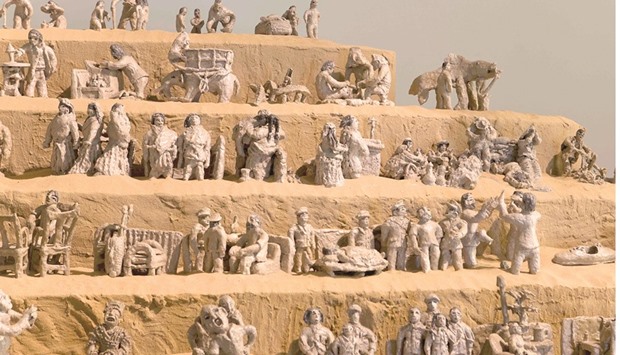As visitors continue to flock to the biggest highlight of the Qatar-China Year of Culture, “What About the Art? Contemporary Art from China” exhibition, presented by Qatar Museums, at the Al Riwaq gallery, one might wonder what do the artists have to say apart from letting their work speak volumes.
In the exhibition that is on until July 16, New York-based Chinese artist Cai Guo-Qiang has put together the compelling works of 15 contemporary Chinese artists that traverses the media of painting, sculpture, installation, video, performance and interactive video game design. Here’s what three of the artists had to say about their art or art in general, in their conversations with Cai.
Hu Zhijun
Born in Hunan, China in 1952, Zhijun worked as a peasant for most of his life. Three years ago, he discovered his interest in sculpture. “What About the Art?” is his debut as an artist as Cai tasked him with making 500 clay sculptures that represent major contemporary Chinese artworks.
Zhijun admits to having gone “crazy” when his wife passed away. “I felt lost, without a destination. My life seemed over. Also, it was not easy for my son to visit me in our hometown. Worried that I was alone, he called and asked me to come to Beijing so that it would be easier for him to take care of me. In Beijing, I had all kinds of jobs, from restaurant cook to janitor. After some time I wasn’t fit to do hard labour, and my son suggested that since my handwriting was so good, I should practice writing with a brush. Before that I had only written with a pen, and had no idea how to write with ink and brush. After that, I started working in clay. I made a little turtle, a yellow fish. I became addicted to the point that I felt weird if I didn’t work with clay on a daily basis.”
On creating sculptures from the works by contemporary Chinese artists based on photographs, Zhijun says, “An artist should do his or her own work to the best extent possible. From Qi Bashi to artists of today, including myself who has only begun this journey, I’ve learned that it is impossible for anyone to reach the apex. Art is too mysterious; it is constantly changing. No one can reach the apex. This is why people say everything has a price – except for art. A painting by an unknown artist is just a piece of scrap paper, and works are only piles of clay. I still feel that I am not an artist, but just a farmer.”
Zhou Chunya
One of the most famous oil painters in China, Chunya is known to integrate “traditional brushwork with forceful strokes and textures, creating a style in which refinedness and violence coexist.” He explains, “My collectors now are all really insightful, and they truly love my art. They aren’t simply trading paintings to make money. However, I think the early stages, when one starts with the market, is very complex. So I tell young artists that in the beginning, they should sell their work to people who aren’t rich yet. It is hard to say that at the beginning, maybe artists are all hyped on making their own money, but they have to be careful. It’s okay to sell one or two works, but when it gets to dozens, one has to be careful. Some people may just love your paintings; others may sell them off. I went to a university to give a lecture. I told the young artists: first of all, try to survive. All those artists doing big things now learned first how to survive. First of all, one needs the ability to survive. As long as they have ideals and faith, they will get there.”
Liang Shaoji
Shaoji perhaps best sums up his decades of artistic pursuit and his ideas about art and artists with one line: “I am a silkworm.” An ingenious artist, Shaoji works with live silkworms that change the artwork with time as they wrap their silk around the objects throughout the show. By channelising the habits and movements of silkworms, Shaoji has created several eye-arresting pieces such as the magical raw silk strands-coated one on display, Moon Garden. His spell-binding installation is the work of 30,000 silkworms.
“When I was in graduate school, I supported myself by making sculptures, wall panels, and flags. That’s where my money came from,” he says, “However, the more I made, the less time I had for other things, and afterward, I lost my money and my studio. All my workers were gone, but I found places for them. I had an interest in the beginning; but if I lose interest I can’t continue anymore. I have also done papermaking and had a wire netting studio but I didn’t continue in the end. So why did I choose silkworms? Because no one has done it yet, any other project would be overdone at an international level. Everyone from the art academy thinks that silkworms are frightening. Especially the girls.”

A closer look at Hu Zhijun’s clay sculptures.


